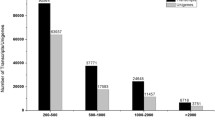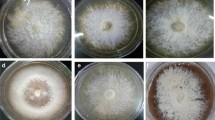Abstract
Auricularia heimuer, an edible jelly fungus, is in considerable demand in Asia due to its high nutritive, economic and medicinal values. RNA-Seq was used to investigate and analyze the mycelium transcriptome of A. heimuer for gene discovery. A total of 26,857 unigenes with an N50 length of 1333 bp were assembled by de novo sequencing. In addition, unigenes were annotated by publicly available databases, including gene descriptions, gene ontology (GO), clusters of orthologous group (COG), Kyoto Encyclopedia of Genes and Genomes (KEGG) metabolic pathways, and protein family (Pfam) terms. A. heimuer was also studied for its wood degradation ability. Thirty-eight putative FOLymes (fungal oxidative lignin enzymes) and 251 CAZymes (carbohydrate-active enzymes) were located from A. heimuer transcriptome. Our study provides a comprehensive sequence resource for A. heimuer at the transcriptional level, which will lay a strong foundation for functional genomics studies and gene discovery of this promising fungus.


Similar content being viewed by others
References
Acharya K, Samui K, Rai M, Dutta B, Acharya R (2004) Antioxidant and nitric oxide synthase activation properties of Auricularia auricula. Indian J Exp Biol 42:538–540
Cantarel BL, Coutinho PM, Rancurel C, Bernard T, Lombard V, Henrissat B (2009) The Carbohydrate-Active EnZymes database (CAZy): an expert resource for Glycogenomics. Nucleic Acids Res 37:D233–238
Conesa A, Gotz S, Garcia-Gomez JM, Terol J, Talon M, Robles M (2005) Blast2GO: a universal tool for annotation, visualization and analysis in functional genomics research. Bioinformatics 21:3674–3676
Fan XZ, Zhou Y, Xiao Y, Xu ZY, Bian YB (2014) Cloning, expression and phylogenetic analysis of a divergent laccase multigene family in Auricularia auricula-judae. Microbiol Res 169:453–462
Finn RD, Bateman A, Clements J, Coggill P, Eberhardt RY, Eddy SR, Heger A, Hetherington K, Holm L, Mistry J (2014) Pfam: the protein families database. Nucleic Acids Res 42:D222–D230
Hatakka and Hamm (2011) Hatakka A, Hammel KE (2011) Fungal biodegradation of lignocelluloses. Mycota. Industrial applications, 2nd edn. Springer, Berlin, pp 319–340
Henrissat B (1991) A classification of glycosyl hydrolases based on amino acid sequence similarities. Biochem J 280:309–316
Iseli C, Jongeneel CV, Bucher P (1999) ESTScan: a program for detecting, evaluating, and reconstructing potential coding regions in EST sequences. In: Proceedings international conference on intelligent systems for molecular biology, pp 138–148.
Lonowicz A, Matuszewska A, Luterek J, Ziegenhagen D, Wasilewska MW, Cho NS, Hofrichter M, Rogalski J (1999) Biodegradation of lignin by white rot fungi. Fungal Genet Biol 27:175–185
Lvasseur A, Piumi F, Coutinho PM, Rancurel C, Asther M, Delattre M, Henrissat B, Pontarotti P, Asther M, Record E (2008) FOLy: an integrated database for the classification and functional annotation of fungal oxidoreductases potentially involved in the degradation of lignin and related aromatic compounds. Fungal Genet Biol 45:638–645
Li RQ, Zhu HM, Ruan J, Qian WJ, Fang XD, Shi ZB, Li YR, Li ST, Gao S, Kristiansen K, Li SG, Yang HM, Wang J, Wang J (2010) De novo assembly of human genomes with massively parallel short read sequencing. Genome Res 20:265–272
Li XB, Luo J, Yan TL, Xiang L, Jin F, Qin DH, Sun CB, Xie M (2013) Deep sequencing-based analysis of the Cymbidium ensifolium floral transcriptome. PLoS ONE 8:e85480
Liu L, Li YH, Li SL, Ni H, He YM, Pong R, Lin DN, Lu LH, Law M (2012) Comparison of next-generation sequencing systems. J Biomed Biotechnol 2012:251364
MacLean D, Jones JD, Studholme DJ (2009) Application of ‘next-generation’ sequencing technologies to microbial genetics. Nat Rev Microbiol 7:287–296
Martinez D, Larrondo LF, PutnamN Gelpke MDS, Huang K, Chapman J (2004) Genome sequence of the lignocellulose degrading fungus Phanerochaete chrysosporium strain RP78. Nat Biotechnol 22:695–700
Metzker ML (2010) Sequencing technologies - the next generation. Nat Rev Genet 11:31–46
Misaki A, Kakuta M, Sasaki T, Tanaka M, Miyaji H (1981) Studies on interrelation of structure and antitumor effects of polysaccharides: antitumor action of periodate-modified, branched-beta-D-glucan of Auriculariaauricula-judae, and other polysaccharides containing-glycosidic linkages. Carbohydr Res 92:115–129
Moriya Y, Itoh M, Okuda S, Yoshizawa AC, Kanehisa M (2007) KAAS: an automatic genome annotation and pathway reconstruction server. Nucleic Acids Res-NAR 35:182–185
Munk L, Sitarz AK, Kalyani DC, Mikkelsen JD, Meyer AS (2015) Can laccases catalyze bond cleavage in lignin? Biotechnol Adv 33:13–24
Ogata H, Goto S, Sato K, Fujibuchi W, Bono H, Kanehisa M (1999) KEGG: kyoto encyclopedia of genes and genomes. Nucleic Acids Res 27:29–34
Sanger F, Nicklen S, Coulson AR (1977) DNA sequencing with chain-terminating inhibitors. Proc Natl Acad Sci U S A 74:5463–5467
Ukai S, Kiho T, Hara C, Kuruma I, Tanaka Y (1983) Polysaccharides in fungi XIV. Anti-inflammatory effect of the polysaccharides from the fruit bodies of several fungi. J Pharmacobio-Dyn 6:983–990
Wang M, Gu BL, Huang J, Jiang S, Chen YJ, Yin YL, Pan YF, Yu GJ, Li YM, Wong BHC, Liang Y, Sun H (2013) Transcriptome and proteome exploration to provide a resource for the study of Agrocybe aegerita. PLoS ONE 2:e56686
Wang F, Li DL, Wang ZY, Dong AR, Liu LH, Wang BY, Chen QL, Liu XH (2014) Transcriptomic Analysis of the Rice White Tip Nematode, Aphelenchoides besseyi (Nematoda: Aphelenchoididae). PLoS ONE 9:e91591
Yang Y, Xu M, Luo QF, Wang J, Li HG (2014) De novo transcriptome analysis of Liriodendron chinense petals and leaves by Illumina sequencing. Gene 534:155–162
Ye J, Fang L, Zheng HK, Zhang Y, Chen J, Zhang ZJ, Wang J, Li ST, Li RQ, Bolund L, Wang J (2006) WEGO: a web tool for plotting GO annotations. Nucleic Acids Res 34:W293–297
Yin YL, Yu GJ, Chen YJ, Jiang S, Wang M, Jin YX, Lan XQ, Liang Y, Sun H (2012) Genome-wide transcriptome and proteome analysis on different developmental stages of Cordyceps militaris. PLoS ONE 7:e51853
Yoon SJ, Yu MA, Pyun YR, Hwang JK, Chu DC, Juneja LR, Mourao PAS (2003) The nontoxic mushroom Auricularia auricula contains a polysaccharide with anticoagulant activity mediated by antithrombin. Thromb Res 112:151–158
Yu GJ, Wang M, Huang J, Yin YL, Chen YJ, Jiang S, Jin YX, Lan XQ, Wong BH, Liang Y, Sun H (2012) Deep insight into the Ganoderma lucidum by comprehensive analysis of its transcriptome. PLoS ONE 7:e44031
Yuan Z, He P, Cui J, Takeuchi H (1998) Hypoglycemic effect of water-soluble polysaccharide from Auricularia auricula-judae Quel. on genetically diabetic KK-Ay mice. Biosci Biotechnol Biochem 62:1898–1903
Yuan Y, Wu F, Si J, Zhao YF, Dai YC (2019) Whole genome sequence of Auricularia heimuer (Basidiomycota, Fungi), the third most important cultivated mushroom worldwide. Genomics 111:50–58
Zeng WC, Zhang Z, Gao H, Jia LR, Chen WY (2012) Characterization of antioxidant polysaccharides from Auricularia auricula using microwave-assisted extraction. Carbohydr Polym 89:694–700
Zhang H, Wang ZY, Yang L, Yang X, Wang X, Zhang Z (2011) In Vitro Antioxidant Activities of Sulfated Derivatives of Polysaccharides Extracted from Auricularia auricula. Int J Mol Sci 12:3288–3302
Zhong MT, Liu B, Wang XL, Liu L, Lun YZ, Li XY, Ning AH, Cao J, Huang M (2013) De novo characterization of Lentinula edodes C91–3 transcriptome by deep Solexa sequencing. Biochem Biophys Res Commun 431:111–115
Zou L, Sun TT, Li DL, Tan Y, Zhang GY, Wang F, Zhang J (2016) De novo transcriptome analysis of Inonotus baumii by RNA-seq. J Biosci Bioeng 121:380–384
Author information
Authors and Affiliations
Corresponding author
Additional information
Publisher's Note
Springer Nature remains neutral with regard to jurisdictional claims in published maps and institutional affiliations.
Project funding: The work was supported by the Fundamental Research Funds for the Central Universities, (Project No. 2572017CF01) and the Harbin University Scientific Research Foundation project, (Project No. HUDF2018105).
The online version is available at https://www.springerlink.com
Corresponding editor: Tao Xu.
Electronic supplementary material
Below is the link to the electronic supplementary material.
Rights and permissions
About this article
Cite this article
Zhang, J., Sun, T., Wang, S. et al. Transcriptome exploration to provide a resource for the study of Auricularia heimuer. J. For. Res. 31, 1881–1887 (2020). https://doi.org/10.1007/s11676-019-00989-8
Received:
Accepted:
Published:
Issue Date:
DOI: https://doi.org/10.1007/s11676-019-00989-8




